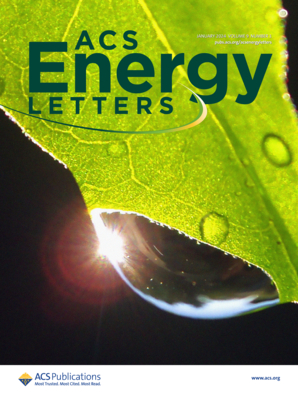Solvation Sheath Reorganization by Alkyl Chain Tuning Promises Lean-Electrolyte Li–S Batteries
IF 19.3
1区 材料科学
Q1 CHEMISTRY, PHYSICAL
引用次数: 0
Abstract
Sparsely solvating electrolyte (SSE), which can achieve a quasi-solid-phase sulfur reaction path, stands out as a promising strategy to alleviate the dependence on electrolyte usage and construct lean-electrolyte lithium–sulfur (Li–S) batteries. Nonetheless, its formation relies upon a high dosage of salt and diluent, thereby leading to increased electrolyte cost. To this end, we herein customize a localized SSE (LSSE) featuring a low ratio of salt-to-solvent and diluent-to-solvent through alkyl chain tuning. A multimodal 2D nuclear magnetic resonance technique is developed to unveil the Li-ion solvation sheath reorganization, which is crucial for studying the coordination and dynamics in liquid electrolytes. LSSE affords an anion-derived solid electrolyte interface and effective restriction of the shuttling effect; hence, our Li–S batteries can sustain a steady operation under 4 μL mgS–1 and 3 mg cm–2. Our work opens a new avenue for advancing SSE design in the pursuit of pragmatic lean-electrolyte Li–S batteries.

通过烷基链调谐实现溶解鞘重组,有望开发瘦电解质锂离子电池
稀溶解电解质(SSE)可实现准固相硫反应路径,是减轻对电解质用量的依赖和构建贫电解质锂硫(Li-S)电池的一种有前途的策略。然而,其形成依赖于高剂量的盐和稀释剂,从而导致电解液成本增加。为此,我们通过烷基链调整定制了一种局部 SSE(LSSE),其特点是盐与溶剂和稀释剂与溶剂的比例较低。我们开发了一种多模态二维核磁共振技术来揭示锂离子溶解鞘重组,这对于研究液态电解质中的配位和动力学至关重要。LSSE 提供了一个阴离子衍生的固体电解质界面,并有效限制了穿梭效应;因此,我们的锂-S 电池可以在 4 μL mgS-1 和 3 mg cm-2 的条件下保持稳定运行。我们的工作为推进固态电解质的设计、追求实用的贫电解质锂-S 电池开辟了一条新途径。
本文章由计算机程序翻译,如有差异,请以英文原文为准。
求助全文
约1分钟内获得全文
求助全文
来源期刊

ACS Energy Letters
Energy-Renewable Energy, Sustainability and the Environment
CiteScore
31.20
自引率
5.00%
发文量
469
审稿时长
1 months
期刊介绍:
ACS Energy Letters is a monthly journal that publishes papers reporting new scientific advances in energy research. The journal focuses on topics that are of interest to scientists working in the fundamental and applied sciences. Rapid publication is a central criterion for acceptance, and the journal is known for its quick publication times, with an average of 4-6 weeks from submission to web publication in As Soon As Publishable format.
ACS Energy Letters is ranked as the number one journal in the Web of Science Electrochemistry category. It also ranks within the top 10 journals for Physical Chemistry, Energy & Fuels, and Nanoscience & Nanotechnology.
The journal offers several types of articles, including Letters, Energy Express, Perspectives, Reviews, Editorials, Viewpoints and Energy Focus. Additionally, authors have the option to submit videos that summarize or support the information presented in a Perspective or Review article, which can be highlighted on the journal's website. ACS Energy Letters is abstracted and indexed in Chemical Abstracts Service/SciFinder, EBSCO-summon, PubMed, Web of Science, Scopus and Portico.
 求助内容:
求助内容: 应助结果提醒方式:
应助结果提醒方式:


